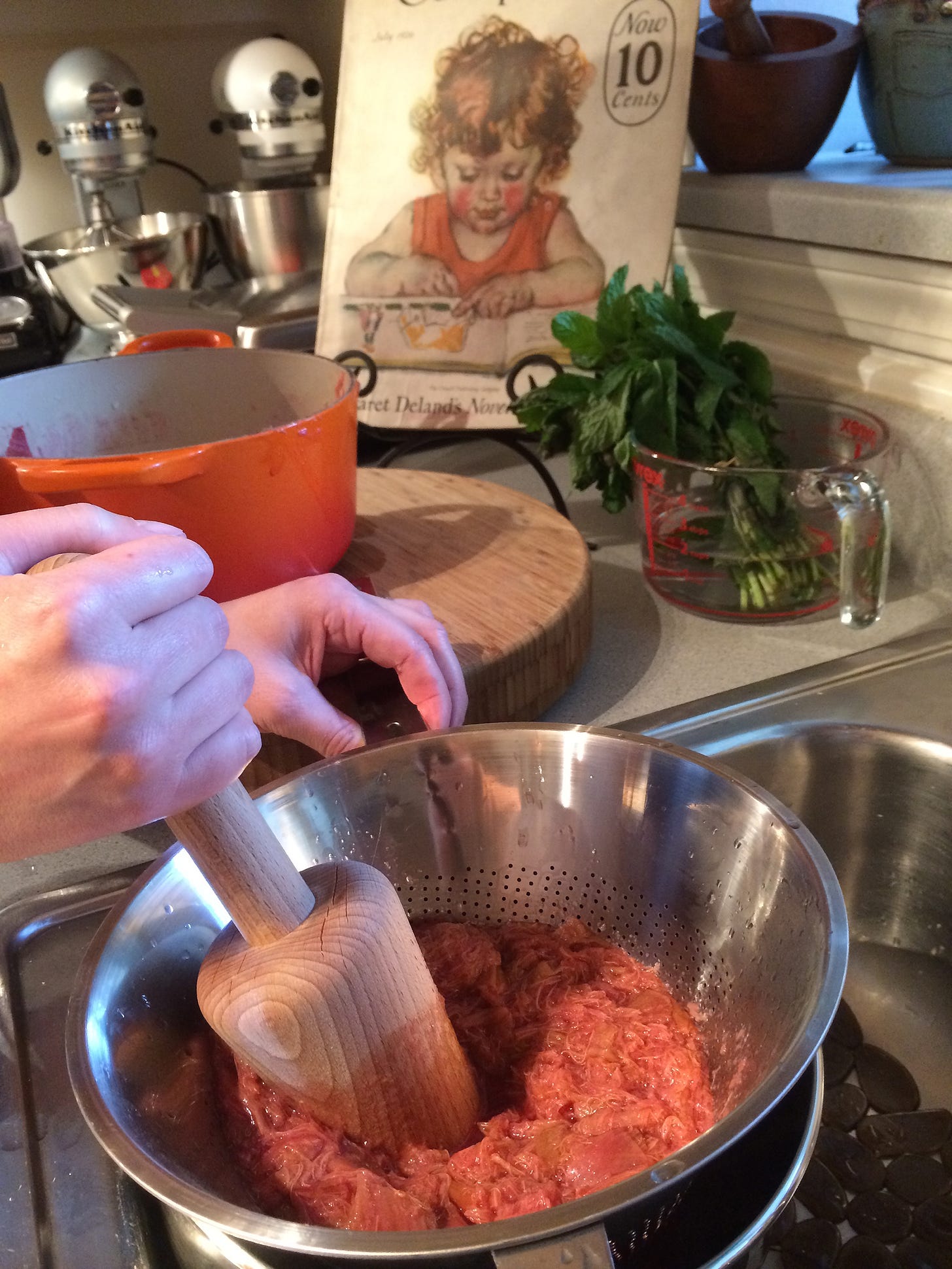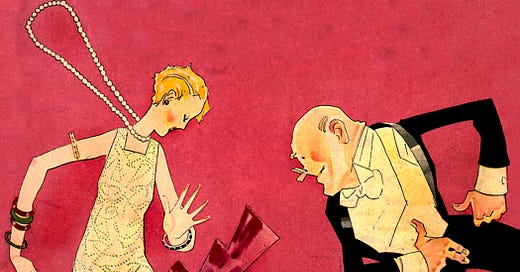Notorious 1920s Summer Afternoon Tea Recipes
Drink recipes especially had a kick during the Roaring Twenties, with or without that secret dram of liquor added to the icy mix.

When the United States went dry during January of 1920, homemade copper stills sprung up behind isolated barns or were hidden deep within heavily wooded areas. These were moonshine distilleries and they supplied illegal watering holes, dubbed “speakeasies,” for the following 13 years until Prohibition ended on December 5, 1933.
The sweet alcoholic drink concoctions at these notorious barrooms and dance halls were created to cover up the nasty taste of rotgut gin. This is the origin of what we lovingly call “artisan cocktails” today.
Yet those strictly non-alcoholic Prohibitionists were thirsty too, and what they served at their afternoon teas had a different kind of kick: caffeine and sugar. Refined fruit punches and cool sorbets included ultra-sweet fruit purées added to long infusions of black caffeinated teas. Prohibitionists’ drinks would certainly take away that sleepy nod at an otherwise dull party; these ‘high-energy’ drink recipes made everyone talkative and animated on a hot summer day.

Nearly every fashion and home decorating magazine during the Prohibition era had drink, frappé, and icy sorbet recipes that were served with tiny cakes and tea sandwiches for summery afternoon parties on the veranda. The articles within these popular and proper publications never as much mention the word ‘alcohol’, but hostesses knew that the recipes were perfectly tasty with or without that notorious jigger of booze.
Frappés were a favorite frosty beverage for Prohibitionists and by the 1920s, everyone had ice boxes in their kitchens, so these recipes were easy to make. In fact, if you were wealthy enough by 1926, you might even afford the newest and smallest in electric domestic refrigerators that sold for a whopping $215 during the time when the average household income was $2100 annually.

Frappés were slushy, frozen fruit concoctions that were favored during especially warm weather in this era before commonplace air conditioning. The inexpensive flavorful ingredients and garnishes could be found in most gardens or marketplaces, just as they are today.
The frappé recipe below was created by food editor Alice Bradley during the mid-1920s. By the time this recipe appeared in the 1926 edition of Woman’s Home Companion, she was also the sole owner of Fannie Farmer’s School of Cookery in Boston. The drink is surprisingly delicious and may well become a favorite in your own home. It may be served like a “slushy” or frozen solid as a sorbet from any home freezer. No ice cream maker required!
Below are my favorite recipes for 1920s drinks and finger foods that were successfully made in my own kitchen:
Simple Rhubarb and Assam Tea Frappé
(8 servings)
1 quart chopped rhubarb
3 pints water
1/3 cup orange juice
4 tablespoons lemon juice
1 1/2 cups sugar
A few grains of salt
1 1/2 cups Assam tea
Optional, to taste: orange or lemon infused vodka
Cook rhubarb, cut in small pieces, with water until soft.
Squeeze through a strainer and add sugar, then boil until sugar is dissolved.
(Be sure to save the rhubarb pulp!)
Add fruit juices and strain through a fine metal strainer, chinois or double layer of cheesecloth.
Add salt, and please be certain, only a pinch. This will make the rhubarb burst with flavor.
Mix thoroughly in a stainless steel bowl then chill in your refrigerator’s freezer to a slushy consistency.
When it is time to serve the drink, mix in 1 1/2 cups black assam tea in addition to the vodka to taste, of course, depending on your vote pro, or against, Prohibition.
Serve garnished with fresh mint leaves.
Note: Freeze the remaining rhubarb pulp for use in pies or other rhubarb treats.

Next, this coffee and orange ice or sorbet has whipped cream folded into it after it has set into a slushy consistency. It is then returned to the freezer until solid. Again, this recipe is perfect for that additional, scandalous, splash of orange liquor or rum just before serving.
Note: The sweet aroma from the orange syrup reduction is heavenly.
Coffee and Orange Ice
(8 servings)
1 quart strong coffee
1 pint (or less) whipped cream
1/4 cup cold water
1 cup orange-sirup [sic]
1 tablespoon gelatin dissolved in water
Note: The alcoholic version adds a splash of orange liquor or rum just before serving
The orange-sirup is made by adding two cups of sugar and one cup of orange-juice and boiling this down to a thick syrup. Dissolve gelatin and add to coffee while hot. Add coffee mixture to the orange-syrup and freeze to slushy consistency, then stir in one pint (or less) of whipped cream. Pack down and freeze until solid.

According to Alice Bradley, “Afternoon luncheons on the porch are one of the most delightful ways of repaying social obligations. Then too, it makes a pleasant ending for a club meeting or a bridge party. If your guests prefer iced tea, pass cream and sugar, in addition to quartered slices of lemon garnished with bits of candied cherry and whole cloves, or drizzled with spiced sirup [sic].” Bradley also advised that simple sandwiches and cakes should always be offered alongside the frappés and iced drinks.
Cream Cheese and Ginger Tea Sandwiches
Mix cream cheese with chopped Canton ginger and chopped nuts, to taste.
Spread on bread and cut into finger shaped strips.
Add fresh watercress into the sandwich or garnish with a single lea on top.
Note: These are amazingly simple nutmeat and ginger finger sandwiches. The recipe is inexpensive to make and surprisingly tasty.
Here’s a few helpful hints:
Ginger: Finely grate about 3 inches of fresh ginger root and add this, along with its juice, to about 1/2 cup soft cream cheese so that it is spreadable.
About 1/2 cup finely chopped pecans or walnuts will work quite well for this recipe.
The sandwiches stay together perfectly when the cream cheese mixture is spread over both slices of tea bread.
Place a single layer of fresh watercress leaves over one slice before closing the sandwich.
Be sure to trim off the crusts, then slice against into 4 long and thin finger sandwiches.

Coconut Cakes
(Makes 10 bite-sized Cakes — but you’ll wish you had more!)
1 fresh coconut (or 2 cups store-bought grated coconut)
7 tablespoons of sugar
2 tablespoons corn sirup [sic]
Rose-colored paste (red food coloring)
1 very fresh egg white
Mix grated coconut with corn syrup and sugar in top of double boiler.
Add food coloring to make a very delicate blushing pink color.
Stir and cook until mixture clings to a spoon.
Carefully fold in the white of one egg and cook until mixture feels sticky when tried between the fingers.
Spread in a wet pan (or atop baking parchment) and cover with wet parchment paper, and cool.
Then, chill additional time in refrigerator until well chilled.
Shape into balls, by first dipping hands in cold water to prevent sticking.
If 1 1/2 tablespoons of mixture are used for each, 10 cakes can be made.
Heat a tin sheet slightly and rub with cooking oil.
Place balls on sheet and bake in slow oven about 20 minutes, being careful that they do not lose their color.
Note:
•To simplify the process, use finely grated coconut from the baking section of your local grocery. If is it too dry and doesn’t resemble the moist nature of fresh coconut, use 2-3 tablespoons of water to rehydrate.
Superfine Baker’s Sugar or Caster Sugar works best instead of coarse table sugar.
Use only the tiniest drop of food coloring to make the cakes appear that subtle blushing pink. Be sure to mix this quite thoroughly so that streaks of color will not appear during baking.
Bake at 285 degrees for 20 minutes. Coconut cakes should be removed *before* they turn golden brown to retain that lovely pink color and texture. They will set up surprisingly well once cooled thoroughly to room temperature.

Yes, indeed! I would love to hear from you! Please take a moment to share your thoughts by clicking this button below. Thank you!
Would you like to send this article to a friend? Please do click the Share button below. Thank you!
If you haven’t already done so, please consider upgrading to one of the Paid memberships by clicking the Subscribe below. Your kind and on-going support of my work is greatly appreciated! Thank you so very much!




Who doesn't like day drinking? The older I get, the more I like it. These recipes are great!